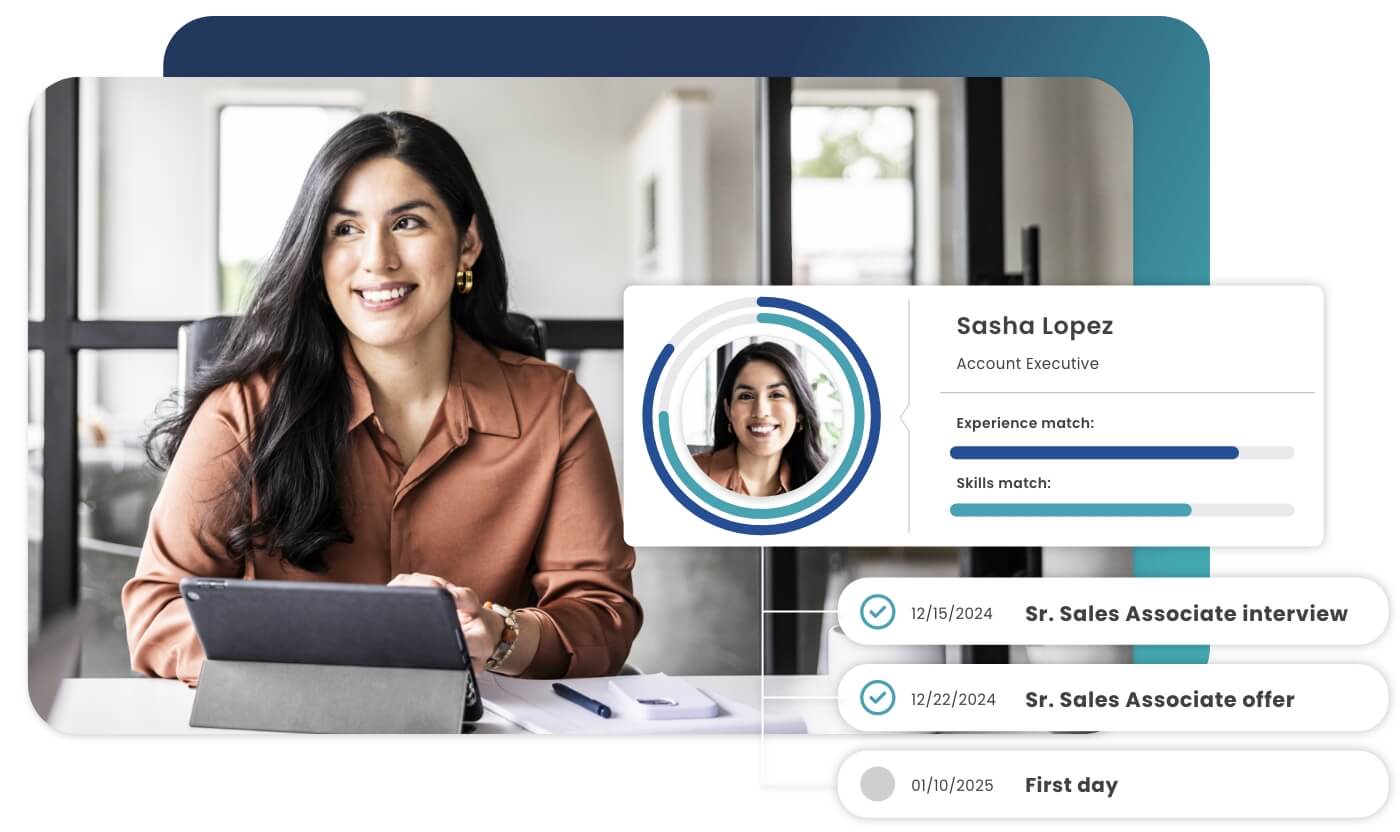

Recruiting in the healthcare industry is a tough job. Recruiters are tasked with filling open roles with high-quality talent – and doing it fast. But finding that talent is increasingly difficult, especially as the medical field’s skill shortages intensify.
To complicate matters more, recruiters’ failure to close open roles — or their selection of less-than-optimal candidates — doesn’t just reflect poorly on the talent acquisition department. It jeopardizes patient care.
Recruiters can’t face stakes like these alone. An applicant tracking system (ATS) is a software application that targets the pain points healthcare recruiters encounter on a daily basis. An ATS pinpoints qualified applicants, elevates the candidate experience, and propels the hiring process.
In this article, we’ll explore the manifold benefits an ATS brings to healthcare recruiting, and we’ll show you the features that will provide the greatest ROI.
Recruiters in healthcare face a host of challenges. First, there’s industry trends to keep up with: High turnover rates plague healthcare organizations, especially since the onset of the COVID-19 pandemic. Lackluster retention isn’t a problem that can be ignored, as hospitals and other care facilities are required to maintain staffing ratios.
Recruiters, then, must keep hiring quick. But that’s no easy task. Talent acquisition in a healthcare setting means recruiters are searching for a wide range of professionals — from administrative professionals to medical specialists.
Healthcare recruiters must work with a wide range of candidates, but they’re often required to find incredibly specific talent. Recruiters may need to hire a neonatal nurse practitioner or a cardiothoracic surgeon. These hires must offer specific degrees, certifications, and credentials.
As recruiters begin to engage such candidates, they’ll find that medical professionals are not the most responsive applicants. These job seekers often work long hours away from a desk or computer. As a result, they’re not only hard to find, but they’re also slow to respond and difficult to engage.
Recruiters facing these challenges need technology that will help them discover, capture and convert healthcare talent. Here’s how an ATS positions recruiters to do just that.
In healthcare, maintaining employee headcount is essential. An ATS helps recruiters reduce time-to-hire by creating efficiencies throughout the hiring process. It filters applicants and engages candidates. It schedules interviews and streamlines internal communications. In other words, an ATS optimizes the recruiting workflow from beginning to end.
Best practices in action: Mercy Health
Hiring fast is one thing. It’s another to hire fast at scale is another. Mercy, a Midwestern healthcare system, prioritized speed in its search for an ATS. As the organization grew, it landed on a system that could propel its search for talent, internally and externally. Today, Mercy hires in just 11 days – and manages 25,000 applicants per month.
When healthcare recruiters adopt an ATS, they’re prioritizing the candidate experience. How? The platform equips recruiters with the technology they need to meet candidates where they are.
Most healthcare candidates aren’t working a job where they can scroll through LinkedIn. They’re on their feet, attending to patients. That means recruiters need to reach them on their phones, with messages that are engaging and easy to act on.
Best practices in action: Corizon Health
For some teams, attracting candidates is the easy part. But not every job or work environment is glamorous. Corizon Health, a leader in the correctional facility healthcare space, needed recruiting technology that would help it compete for nurses and physicians. The organization adopted iCIMS ATS so its recruiting team could offer a better candidate experience — one that set Corizon apart in the eyes of hard-to-find talent.
Healthcare recruiters know they need to hire candidates fast. But that doesn’t mean they can compromise on compliance. An ATS captures and reports on EEO data, helping make sure recruiters’ hiring practices align with anti-discrimination statutes.
An ATS also gives recruiters insight into the hiring process, highlighting areas ripe for optimization. Along the way, the system measures ROI, showing how changes have reduced metrics like time-to-fill and time-to-hire.
Recruiting isn’t accomplished in isolation; recruiters are forever checking in with other stakeholders, from hiring managers to company leaders. In a healthcare setting, these communication loops often come undone. An ATS streamlines this collaboration, keeping busy hiring informed without bombarding them with notifications, emails or tasks.
Healthcare recruiters face many frustrations — their tech shouldn’t be one of them. An ATS allows users to configure its platform to serve their unique business processes. Users can also make changes to their ATS the moment they’re needed.
This flexibility goes beyond customization. An ATS serves healthcare recruiters by integrating with the systems they already have in place. After linking their ATS with their HRIS or payroll system, recruiters save time as they onboard new hires, search for internal candidates and manage their budgets.
Recruiters will also benefit from integrations with recruiting solutions they use for background checks, talent assessments and other steps essential to the healthcare hiring process.
Best practices in action: Hackensack Meridian Health
Recruiting software that scales with you – and is flexible enough to tackle new challenges – is invaluable. Just ask Hackensack Meridian Health, a healthcare network boasting more than 33,000 employees. Their HR team rolled out iCIMS to the entire organization during a merger – and hired 4,000 new medical professionals during the process.
You’re now familiar with the benefits an ATS provides healthcare recruiters. Next, let’s dive into the functions that make these benefits possible.
An ATS allows recruiters to build workflows that achieve their team’s specific needs. This allows recruiters to customize their processes based on job types, locations, geographies and other factors.
An ATS makes sure recruiters always have access to a rich supply of talent. Healthcare recruiters who need to make quick work of the hiring process need more than a vast array of options, however. They also need advanced search and filtering tools to see which candidates outshine the rest.
Healthcare recruiters face fierce competition for talent. It’s crucial, then, that they outshine other employers in their candidate communication game. Automated communication tools and recruitment marketing campaigns give recruiters a leg up. These tools allow recruiters to get in touch with candidates quickly, and in a way that positions their employer as personal and inviting.
Best practices in action: NorthStar Anesthesia
Recruiting is easier when your team isn’t bogged down with repetitive, manual tasks. NorthStar Anesthesia, a fast-growing anesthesia management company, needed a solution to hire highly specialized talent at scale. The company chose iCIMS to provide their candidates with a high-touch, personalized experience — while leveraging automation for scale.
With their ever-growing to-do lists, healthcare recruiters need to take advantage of modern tools that can whittle down their workload. An ATS equipped with AI does just that. GenAI tools assist recruiters in creating communications, personalizing campaigns and bolstering candidate engagement. Meanwhile, conversational AI helps capture job seekers’ attention.
An ATS is a well of information. It features robust reporting and analytics for both compliance and performance tracking. It can also be configured to show specific metrics, track DEI progress, generate executive reports, and more.
Onboarding is often a forgotten task, and regrettably so. Onboarding bridges the gap between new hires and successful staff — a transition turnover-ridden healthcare organizations can’t afford to botch.
An ATS optimizes the onboarding experience for all involved. It offers portals where new hires can submit online forms and track their progress. For internal teams, it automates communication and sends reminder for things like creating ID badges, providing tech access, and printing parking permits.
Best practices in action: Novant Health
Sometimes its small optimizations that make the biggest impact. Novant Health, an integrated network of healthcare facilities, upgraded from its legacy ATS to improve the candidate experience. The switch also provided the organization better data and an opportunity to align with the company’s strategic vision to transform HR. By modernizing their onboarding process, Novant saves $300,000 per year.
An ATS is a platform built for recruiting alone. In any industry, it equips talent acquisition professionals with the tools they need to make better hires. But the tool is especially effective for healthcare recruiters.
By pinpointing qualified talent, elevating candidate engagement and harmonizing internal communications, the tool optimizes the entire hiring process. These benefits work together to put quality talent in position as quickly as possible, keeping patient care the No. 1 priority.
Ready to learn more about iCIMS ATS? Check out our comprehensive guide here.